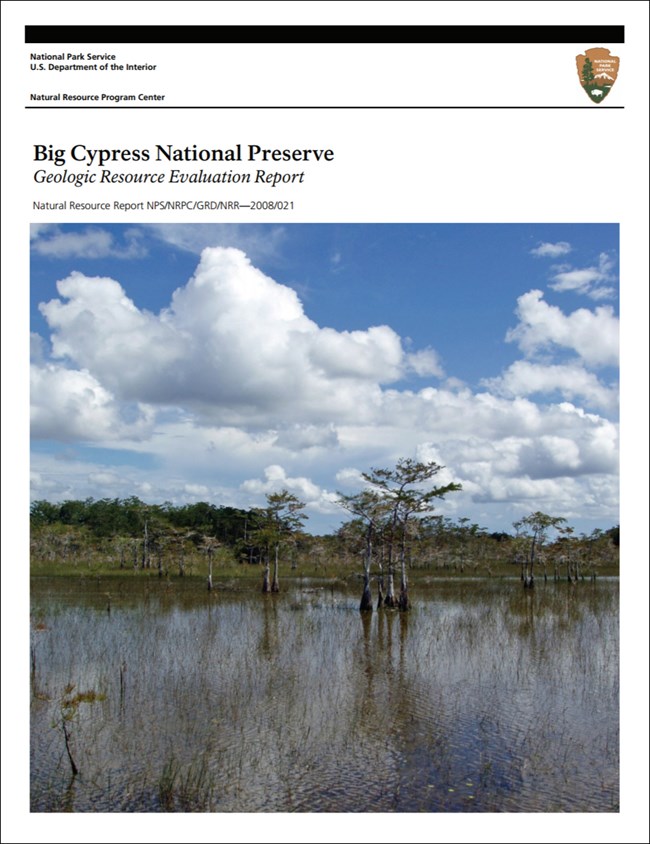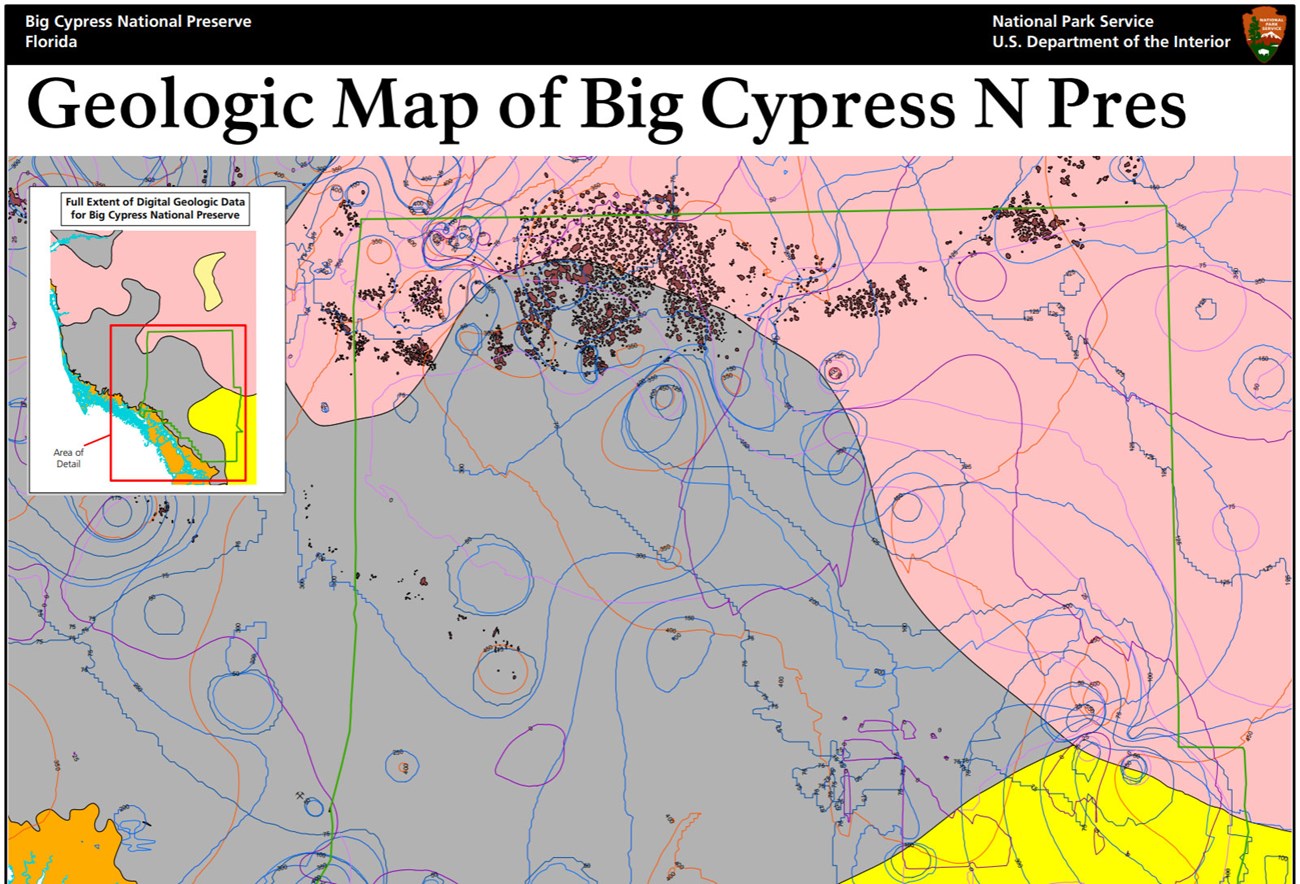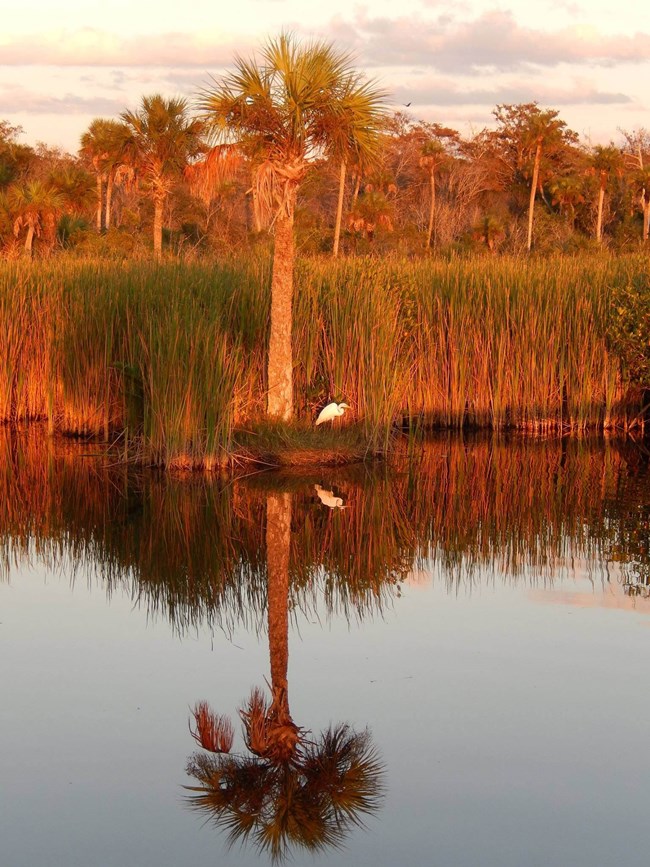Last updated: June 17, 2024
Article
NPS Geodiversity Atlas—Big Cypress National Preserve, Florida
Geodiversity refers to the full variety of natural geologic (rocks, minerals, sediments, fossils, landforms, and physical processes) and soil resources and processes that occur in the park. A product of the Geologic Resources Inventory, the NPS Geodiversity Atlas delivers information in support of education, Geoconservation, and integrated management of living (biotic) and non-living (abiotic) components of the ecosystem.

Geologic Features and Processes
Located in the part of South Florida that also includes the Everglades, Big Cypress National Preserve is part of a unique area on Earth. Habitats at Big Cypress National Preserve include estuarine areas, slow- flowing freshwater sloughs, saline marshes, freshwater marshes, cypress swamps, prairies, domes, strands, mangrove zones, buttonwood ridges, coastal prairies, freshwater marl prairies, hardwood hammocks, and pinelands. The geology of the area has shaped these environments. Geology influences surface water flow, thus contributing to climate, weather, hydrology, and topography in Florida. Geologic units and structures are the basis for the extensive aquifers and the presence of oil and gas beneath Big Cypress National Preserve.
The Big Cypress area is one of the lowest, youngest, and most geologically stable platforms of North America. This overall stability belies dynamic geologic processes at work on the landscape of South Florida. With its low- lying landmass, South Florida has been repeatedly submerged and exposed with variations in sea level over the past 50,000 years. Beneath the surface at Big Cypress are thousands of feet of roughly horizontal geologic layers that are rich in carbonate minerals. These minerals dissolve in rainwater and groundwater made acidic by decaying organic materials. Dissolution of interconnected spaces in the subsurface of South Florida ultimately results in a karst landscape defined by solution holes, sinkholes, disappearing streams, and springs. Such a landscape can store a great deal of water.
From the late 1800s, human population has steadily increased in South Florida. Canals, ditches, dams, and levees drained swamps for agriculture, oil and gas exploration, and urban development. Thus people have forever altered the once- steady, slow flow of fresh water from Lake Okeechobee south to Florida Bay along the “River of Grass”—the Everglades. This ecosystem is rapidly changing and is threatened with destruction. A comprehensive, multiagency cooperative research effort is underway to restore water flow and preserve what remains of the once vast wetlands of South Florida. An increased understanding of geologic resources is important to these efforts at Big Cypress National Preserve.
South Florida Basin
Big Cypress National Preserve lies within the northeastern part of the South Florida basin (200,000 km2, or 80,000 mi2), the thickest part of which is northwest of the Florida Keys, beneath Florida Bay. Deposition of mixed carbonate, evaporite, and clastic sediments in the subsiding basin has been more or less continuous since the Late Jurassic. Several large, positive structural features surround the basin: the Florida escarpment to the west (a major barrier reef complex that separates the Florida Shelf from the deep Gulf of Mexico basin), the Peninsular arch to the east, the Pine Key arch to the southeast, and the Tampa- Sarasota arch to the northwest. The most prominent of these— the Peninsular arch—is a crystalline basement feature of Paleozoic age that plunges south- southeast along the length of the Florida Peninsula. This arch controlled the deposition patterns of Jurassic and Cretaceous sediments. Beneath South Florida, units of these ages onlap, wedge, or pinch out against the arch (Pollastro et al. 2000).
Stratigraphic Record
Cores drilled during oil and gas exploration reveal a thick and time- extensive stratigraphic sequence underlying the preserve. In the oil and gas producing areas of Big Cypress, the sedimentary sequence is 4,572−5,182 m (15,000−17,000 ft) thick (Pollastro et al. 2000). This sequence overlies Jurassic volcanic rocks (rhyolite and basalt) and consists of some of the oldest rocks in Florida. The sedimentary rocks of Big Cypress fill the South Florida basin, described above.
The earliest sediments, part of the Wood River Formation, are continental clastic rocks overlain by salt, limestone, anhydrite, and brown dolomite. Between the Wood River and the oil- producing Sunniland Formation lie the predominantly carbonate- evaporite Bone Island and Pumpkin Bay Formations, and the Glades Group of shale, dolomite, and anhydrite (Faulkner and Applegate 1986). The Lower Cretaceous Sunniland Formation is composed of anhydrite, a thin limestone layer, and dolomite. The Sunniland; the anhydrite and limestone of the Lake Trafford Formation; and the dolomite, limestone, and anhydrite of the Rattlesnake Hammock Formation make up the Ocean Reef Group (Pollastro et al. 2000).
The Big Cypress Group and Naples Bay Group overlie the Ocean Reef Group. These are largely dolomite and anhydrite beneath Big Cypress National Preserve. The Upper Cretaceous Pine Key Formation is composed of chalky limestone and dolomite. It is approximately 914 m (3,000 ft) thick. The Paleocene to present- day sedimentary layers overlie the Pine Key Formation at Big Cypress (Faulkner and Applegate 1986). Relatively uninterrupted Tertiary deposition amassed the grand carbonate platform of South Florida. These sediments reach great thicknesses, approximately 1,676 m (5,500 ft).
Cores drilled in nearby Everglades National Park help determine the stratigraphy of younger units at Big Cypress National Preserve. Eocene to late Oligocene deposition resulted in the marine carbonates of the Avon Park Formation, the Suwannee Limestone, the Ocala Group, and the Arcadia Formation of ramp- setting carbonates with scant quartz content increasing northward (Cunningham 2005).
A major disconformity marks the boundary between the Arcadia Formation and the overlying Peace River Formation. In other areas of Florida, the Hawthorn Group (Miocene) is between the Arcadia and Peace River Formations. The Peace River Formation contains two distinct units: a lower diatomaceous mudstone, and an upper muddy, fine- grained quartz sandstone (Cunningham et al. 1998). Deposited atop the Peace River Formation is the Tertiary age Tamiami Formation. This unit comprises much of the surface outcrop at Big Cypress.
Hydrogeology
Possibly the most distinctive features of the South Florida wetland ecosystem are the gently sloping landscape and its large capacity for long- term water storage. Prior to anthropogenic alterations and water management practices, water flowed very slowly through the system, buffering the ecosystem from extreme changes caused by droughts and floods. Understanding this system means understanding the relationship between geology and water flow at Big Cypress National Preserve (Florida Department of Environmental Protection 2005).
“Hydrogeology” refers to the study of groundwater movement with specific emphasis on its relation to the surrounding geology, modes of movement, and water chemistry (Florida Geological Survey 2005). This study combines hydrology, geology, chemistry, physics, biology, mathematics (modeling), and engineering to understand the characteristics of groundwater movement in the complex and enigmatic subsurface.
Freshwater Sloughs, Strands, and Domes
Water at the preserve does not flow in well- defined streams and rivers (NPS 2006). Instead, water flows around elongated bands of cypress trees called “strands,” cypress domes, and through extensive, meandering marshy areas referred to as “sloughs” that characterize the Big Cypress Swamp (Miller et al. 2004).
In the southeastern United States, a slough refers to a type of swamp or shallow lake system that is similar to a bayou with trees (Neuendorf et al. 2005). At Big Cypress National Preserve, a slough forms where the surface of the ground coincides with the shallow water table). Sloughs are a critical source of fresh water for wildlife, especially during seasonal droughts. Sloughs also accumulate nutrients for soils and vegetation (Taylor Schoettle 2006).
Cypress trees cover approximately one- third of the preserve, in many places lining the sloughs in strands (NPS 2006). Strands form where high water level and sufficient flow result in a channel along a depression (USDA Forest Service 2006). Most of these trees are dwarf pond cypress (Taxodium distichum), with a few areas of giant, bald cypress trees, some of which are 600−700 years old.
The cypress may also be present in cypress domes, mixed hardwood and cypress swamps, and “hatrack” cypress (a dwarf species) communities. Cypress domes are relatively small, discrete areas of freshwater swamp dominated by bald cypress trees.
The term “dome” refers to the characteristic configuration of larger trees growing in the center of the area with progressively shorter trees growing towards the edges. These domes and forests tend to coincide with solution collapse (karst processes) of near- surface limestone caprock. The depression collects nutrients and allows deeper root penetration for larger tree species (NPS 2006; USDA Forest Service 2006).
Hardwood Hammocks
Hardwood hammocks are areas of closed canopy forests of dense vegetation dominated by evergreen and semi- deciduous tree and shrub species (U.S. Fish and Wildlife Service 2007). At the preserve, as well as in neighboring Everglades National Park, the hammocks contain some of the rarest and most unusual plant and animal species in South Florida. The existence of the hammocks is dependent upon the underlying geology and hydrogeologic processes. Hammocks develop on land that is slightly higher than that of the surrounding marshes and prairies. In South Florida, this elevation difference is generally less than 3 ft (1 m).
Cave and Karst
According to the USGS Karst Map of the United States, the entire preserve is considered karst. There are three separate, complex aquifers starting at the surface with the Biscayne Aquifer that is composed of Holocene to Pleistocene sandstone units and Pliocene Miami Limestone. The Miami Limestone developed large solution cavities when sea level and the water table were lower than present. This aquifer has a very large capacity for long-term water storage. The carbonate- rich layers in these units are highly susceptible to dissolution from acidic rain and groundwater. The extensive carbonate rocks of Florida have been exposed to terrestrial weathering processes since the last significant interglacial period led to the flooding of the Florida platform some 130,000 years ago. Since that time, much of the original rock has been altered and/or dissolved by acidic rainwater and groundwater undersaturated with respect to calcium carbonate. Deep Lake, a large water-filled sinkhole approximately 300 in diameter and 90 feet deep, probably formed during this time. This feature is probably a water-filled cave. There may be a more extensive cave system associated with this feature and in possibly other locations within the preserve as well. The 2nd aquifer is the Gray Limestone Aquifer which is formed in the Lower Tamiami Formation, a Pliocene limestone that is a lightly cemented fossiliferous, sandy limestone. The 3rd aquifer is the Sandstone Aquifer, composed of LeHigh Acres Sandstone.
Big Cypress Swamp is a recharge area for the aquifers. The interaction between groundwater flow and the overall ecological quality of freshwater must be quantitatively determined at Big Cypress National Preserve. The karst aquifer system of South Florida is open to recharge of water from precipitation, surface flow, and man- made diversions (such as canals, ditches, ponds). The underlying Tamiami Formation forms part of the near surface aquifer beneath Big Cypress National Preserve. Understanding the nature of the hydrologic exchange between surface and ground waters is critical to understanding the movement of water and dissolved nutrients, wastes, metals, and other substances in the Big Cypress ecosystem.
All NPS cave resources are protected under the the Federal Cave Resources Protection Act of 1988 (FCRPA)(16 U.S.C. § 4301 et seq.).
Paleontological Resources
Mapped, fossil-bearing rock units exposed at the surface at Big Cypress are limited to:
- Tamiami Formation (Upper Pliocene)
- Undifferentiated Shell-Bearing Sediments (Pliocene–Pleistocene)
- Miami Limestone (upper Pleistocene)
- Sedimentary deposits (Holocene) (Scott et al. 2001)
See the park Geologic Resources Inventory Report for more information on fossils in these areas.
The park's fossil resources present opportunities for resource management (including field surveys, inventory, and monitoring), education, interpretation, and continued or future scientific research.
All NPS fossil resources are protected under the Paleontological Resources Preservation Act of 2009 (Public Law 111-11, Title VI, Subtitle D; 16 U.S.C. §§ 470aaa - 470aaa-11).
Oil and Gas
Oil and gas development has been ongoing at Big Cypress for over 50 years. More than 200 wells in 14 fields (8 of which are still active) have been drilled along the Sunniland trend. The Sunniland Formation is among the Cretaceous units that pinch out along the Peninsular arch. The sediments that became the Sunniland Formation were deposited in tidal shoals and carbonate reef environments. The Sunniland is sealed below and above by the salt and evaporite deposits of the Punta Gorda Anhydrite and the Lake Trafford Formation, respectively (Pollastro et al. 2000) and have been found to trap hydrocarbons along the Sunniland Trend. The Sunniland and Dollar Bay Total Petroleum System is 32 km (20 mi) wide and 240 km (150 mi) long; it trends northwest to southeast through Lee, Hendry, Collier, and Dade Counties and passes through the north and east boundaries of Big Cypress National Preserve. The petroleum is located at depths of between 3,350 and 3,660 m (11,000 and 12,000 ft) below the surface. The porous reservoir developed on a subtle structural high within the Sunniland Formation.
It is estimated that Big Cypress National Preserve covers 6% of the trend. Other exploration continues in a second defined petroleum system, the Pre Punta Gorda Total Petroleum System (4,570−4,880 m [15,000−16,000 ft] deep). This second system is part of the Wood River Formation, which contains lower Cretaceous dolomite and clastic rocks. The Wood River pinches out against a structural high, creating a natural trap for petroleum storage. Big Cypress National Preserve covers 8% of the area of this system (Norby 2005).
Regional Geology
Big Cypress is a part of the Coastal Plain Physiographic Province and shares its geologic history and some characteristic geologic formations with a region that extends well beyond park boundaries.
- Scoping summaries are records of scoping meetings where NPS staff and local geologists determined the park’s geologic mapping plan and what content should be included in the report.
- Digital geologic maps include files for viewing in GIS software, a guide to using the data, and a document with ancillary map information. Newer products also include data viewable in Google Earth and online map services.
- Reports use the maps to discuss the park’s setting and significance, notable geologic features and processes, geologic resource management issues, and geologic history.
- Posters are a static view of the GIS data in PDF format. Newer posters include aerial imagery or shaded relief and other park information. They are also included with the reports.
- Projects list basic information about the program and all products available for a park.
Source: NPS DataStore Saved Search 2718. To search for additional information, visit the NPS DataStore.
A NPS Soil Resources Inventory project has been completed for Big Cypress National Preserve and can be found on the NPS Data Store.
Source: NPS DataStore Saved Search 2783. To search for additional information, visit the NPS DataStore.
Related Articles
Big Cypress National Preserve
National Park Service Geodiversity Atlas
The servicewide Geodiversity Atlas provides information on geoheritage and geodiversity resources and values within the National Park System. This information supports science-based geoconservation and interpretation in the NPS, as well as STEM education in schools, museums, and field camps. The NPS Geologic Resources Division and many parks work with National and International geoconservation communities to ensure that NPS abiotic resources are managed using the highest standards and best practices available.


